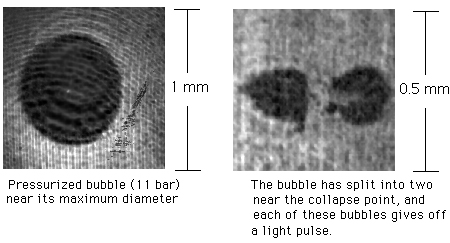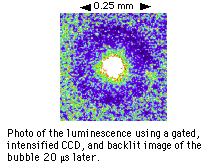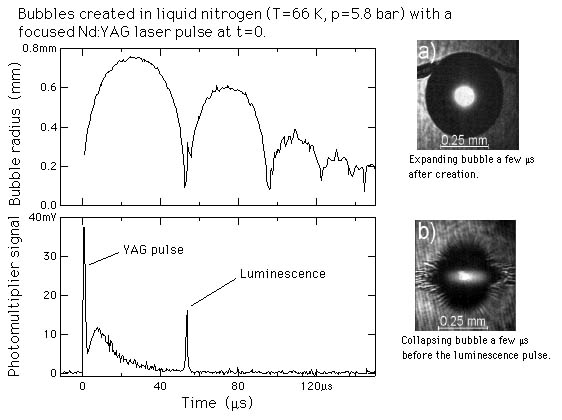sonoluminescence in cryogenic liquids, such as alcohols, liquid nitrogen
and liquid oxygen. The emission of ultrashort light pulses (less
than 100 ps in length) from small gas bubbles in water has been
extensively studied, but the details of the light-emitting
mechanism are still not known. A problem with water is that
it completely absorbs the light emitted in the ultraviolet, which
is where the sonoluminescence intensity is the highest. The
cryogenic liquids absorb considerably less in the ultraviolet,
and could allow this region of the spectrum to be studied in much
greater detail.
Initial experiments were undertaken to see if sonoluminescence could
be observed in these liquids. We were able to trap bubbles in
alcohol
at temperatures down to -150 F, where the intensity of the sonoluminescence
increased by a factor of more than 100 from its value at room temperature.
At the lowest temperatures we discovered that hemispherical bubbles
could be
stably trapped on solid surfaces in the cell, and that they could still
emit
sonoluminescence just like the spherical bubbles at the center of the
cell.
This work is described in the article: K. R. Weninger,
H. Cho, R. A.
Hiller, S. J. Putterman, and G. A. Williams, Sonoluminescence from
an Isolated Hemispherical Bubble on a Solid Surface, Phys. Rev.
E 56, 6745 (1997).
Download the PDF file (177 Kb)
We were also able to trap helium bubbles in both liquid nitrogen and
liquid oxygen at even lower temperatures (-350 F), and studied
the characteristics of the bubble oscillations using laser scattering
techniques. However, we were unsuccessful in observing any
sonoluminescence in these liquids; the bubbles would become unstable
and no longer trap as the sound amplitude was increased.
These experiments are described in : O. Baghdassarian, H. Cho,
E. Varoquaux,
and G. A. Williams,Trapped Bubble Dynamics in Cryogenic Fluids,
J. Low Temp. Phys. 110, 305 (1998).
Download the PDF file (130 Kb)
Since the acoustic trapping technique did not seem to work, we
recently turned to another technique for studying bubbles in liquids,
which is
to create a single bubble using a focused pulse of laser light.
This technique,
pioneered in Russia in the 1970's, creates a single bubble as the liquid
is vaporized
by the intense laser energy. The bubble grows to as much as a
millimeter in size,
and then collapses, compressing the gas inside, and right at the collapse
point a
pulse of light is emitted. We have recently studied this process
in great detail for
the case of water at room temperature, and made a number of interesting
observations:
- the duration of the light pulse is a few nanoseconds, and increases as the bubble
- the intensity of the light pulse is independent of any dissolved gas in the water
- when the water is pressurized the light pulse splits into two pulses separated by
split into two separate bubbles just before the collapse point.

These results are discussed in our recent paper: O. Baghdassarian, B. Tabbert,
and G. A. Williams, Characteristics of Luminescence from Laser-Created Bubbles in Water,
Phys. Rev Lett. 83, 2437 (1999). Download the PDF file (560 Kb)

We have also recently observed luminescence from laser-created bubbles
in liquid nitrogen and
liquid argon. The unusual feature that we see is a very
long pulse duration of the emitted
light, ranging from 100 nanoseconds for the smallest bubbles up to
1000 nanoseconds for the
largest millimeter-sized bubbles. This is about 100 times longer
than the pulses we observed
for the similar bubbles in water. We do not understand these
interesting observations yet, and
further measurements are being undertaken. A preprint of this
work (accepted for publication in Physica B) can be found on the web
here.
